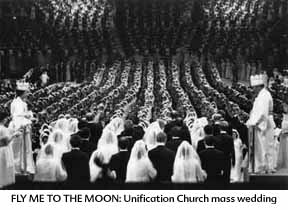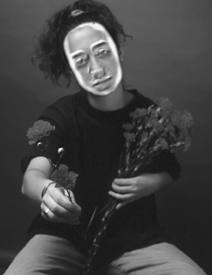

Cults and mind manipulation: pathology or path of righteousness
By LYNNE CHRISTENSEN and LEWIS E. MARSHALL
 WHAT DO
THE inferno at Waco, the
nerve-gas bombing in a
Japanese subway, and the mass suicide at Jonestown have in common?
Perhaps less than one might think. Opinions differ about the degree of correspondence among
groups referred to as cults. Although the Cult Awareness Network (CAN) lists
common characteristics that identify destructive cults, Gillian Lindt, dean of Columbia's School of General Studies and
an expert in religious protest movements, asserts that what is termed cultic behavior is not
easily defined by common patterns. Different "cults" appeal to completely
different constituencies, and lumping them together is dangerously inaccurate.
WHAT DO
THE inferno at Waco, the
nerve-gas bombing in a
Japanese subway, and the mass suicide at Jonestown have in common?
Perhaps less than one might think. Opinions differ about the degree of correspondence among
groups referred to as cults. Although the Cult Awareness Network (CAN) lists
common characteristics that identify destructive cults, Gillian Lindt, dean of Columbia's School of General Studies and
an expert in religious protest movements, asserts that what is termed cultic behavior is not
easily defined by common patterns. Different "cults" appeal to completely
different constituencies, and lumping them together is dangerously inaccurate.According to Lindt, the word cult originally denoted any religious group that emphasized worship and ritual over doctrine but has been reappropriated as a pejorative term for a wide variety of unpopular groups. A shift in meaning toward derogation of groups that did not practice what was considered "appropriate religion" began as early as the 17th century.
Terminology aside, society has a continuing interest in identifying destructive trends in religious movements, within either well-established institutions or groups that the mainstream considers suspect. In spite of advancing skepticism about--and mass defection from--organized religion, it has proved to be a durable part of human culture and behavior. However, widely held social mores clash with the teachings of many religious systems. Distinctions between religions and cults are still made, often on the basis of how the latter groups purportedly manipulate the thinking of individual members.
The CAN has put forth certain definitions and descriptions of destructive cults, including what it calls techniques of mind control, drawing heavily on the work of Drs. Margaret Singer and Robert Jay Lifton. Lifton studied the "brainwashing" techniques used on civilians in mainland China and on prisoners of war during the Korean conflict; Singer and psychologist Richard Ofshe have used his work to analyze the techniques they have observed in contemporary cults. Characteristics listed by the CAN include:
- Leader is self-appointed and on a unique, messianic mission
- Leader seeks to be the center of worship
- Leader assumes absolute and complete authority over members
- Cult assumes totalistic control over the conduct of members
- Cult has two purposes, recruiting new members and fund raising
- Cult professes a new and only way to solve life's problems
- Cult has double set of ethics, one for insiders and one for outsiders, and insists upon secrecy
- Cult places emphasis on doomsday issues
 CAN also
specifies "Techniques of Mind Control" used by cults, including group pressure,
isolation or separation, thought-stopping techniques (meditation, chanting, and repetitious
activities), fear and guilt used to elicit confessions, sleep deprivation, inadequate nutrition,
and sensory overload. Interestingly, many of the world's religions prescribe practices such as
fasting, meditation, pilgrimage, vigil, public confession and penance, and chanting or
repetitive prayer, suggesting that the border between behaviors said to deepen spiritual
experience and behaviors perceived as elements of mind control may not be absolute.
CAN also
specifies "Techniques of Mind Control" used by cults, including group pressure,
isolation or separation, thought-stopping techniques (meditation, chanting, and repetitious
activities), fear and guilt used to elicit confessions, sleep deprivation, inadequate nutrition,
and sensory overload. Interestingly, many of the world's religions prescribe practices such as
fasting, meditation, pilgrimage, vigil, public confession and penance, and chanting or
repetitive prayer, suggesting that the border between behaviors said to deepen spiritual
experience and behaviors perceived as elements of mind control may not be absolute.
Exploding stereotypes: Can we learn from Waco?
IN THE UNITED States, with its ethnic and religious diversity, its tradition (or at least ideal) of respecting the religious liberty of all citizens, and its constitutional rejection of any established church, deliberations over how the secular and religious realms interact are more complicated than in more homogeneous countries with at least nominal religious establishments. The U.S. government is expected to respect religious liberty yet still protect citizens from harm. During the FBI's standoff with the Branch Davidians, Attorney General Janet Reno attempted to define the boundary between freedom of religious expression and unlawful activity. The violent outcome did little to clarify this distinction.
However real the danger at Waco was, social conditioning and preconceptions may have biased the judgment of both Reno and her sources of information. Says Lindt, who recently discovered that she is on the FBI's list of experts on religious cults: "It is amazing how willing Janet Reno was to believe the stereotypes often assigned to so-called cults, abuse of children among them, on the basis of limited and one sided evidence." The Branch Davidians believed David Koresh was unmasking the seven seals from the Book of Revelation; the FBI saw him as a dangerous hoarder of weapons who had barricaded himself and his followers in a compound. The reality of the situation proved too complicated for either perspective to apprehend.
In the aftermath of Waco, many questions arise: How can society be better prepared to deal with similar situations? Can outsiders learn anything about the nature of "cultic" groups that will allow a more constructive response, identifying warning signs in time to avoid deadly confrontations?
The robotic stereotype of group members may be a problematic assumption. Lindt believes that mind-control techniques are not as effective as others in the field, such as CAN, may believe. People drawn to cults have needs they perceive the group can meet. "Followers play a fairly active role in selecting among the options that the leaders are offering," she says, "and groups draw from people who are looking for others to make decisions for them."
Lindt does not believe that mind-control techniques of cults are parallel to the torture techniques studied by Lifton; few cults come anywhere close to those extremes. According to Lindt, deprogrammers are seldom responsible for defections from cults. The majority of refugees from cults leave voluntarily. The same techniques used to recruit people into cults, she observes, are used by deprogrammers to get them out. "People who are susceptible to join cultic groups tend to be vulnerable and have low self-esteem to begin with. They are then twice weakened by the deprogrammers who 'rescue' them."
Followers often help form the group disciplines, the leader's agenda is not always adopted without question, and followers often project their own needs onto the leader. Lindt uses the People's Temple as an example. The followers of Jim Jones consistently rejected his idiosyncratic version of Marxist ideas until he had obtained the greater isolation of his community in Guyana. Isolation seems to produce the more extreme manifestations of many cults; in completely closed communities, members have no way of testing what the leader says against other sources.
"Cults are not a 20th century phenomenon," Lindt emphasizes. "There have always been gurus wandering around asking for supporters and having new messages, and there will be more and more as we get closer to the year 2000." As that year approaches and fringe beliefs continue to proliferate, we are left with a mandate to examine our own preconceptions as we attempt to protect two values that uneasily coexist: freedom of religious expression and the often destructive manifestations of religious fervor.
PHOTO CREDITS:
UPI/Bettman (1); Jonathan Smith/Special effects by Howard Roberts (2).
LYNNE CHRISTENSEN, a free-lance
medical and scientific writer, has contributed to Genetic Engineering News,
Cosmopolitan, and the online news service BioWorld. LEWIS E.
MARSHALL is an Episcopal priest and free-lance writer.




